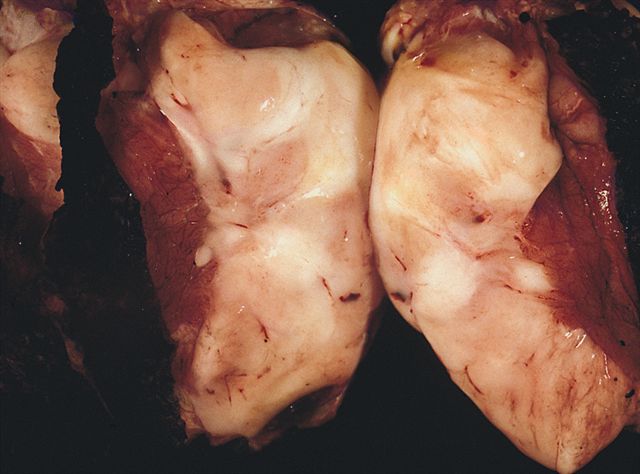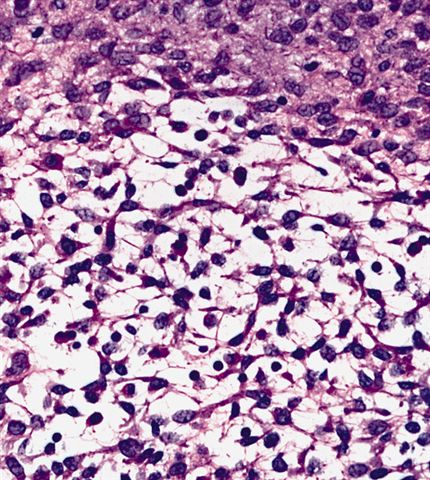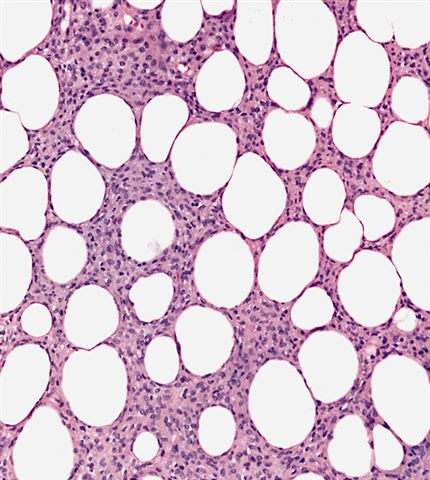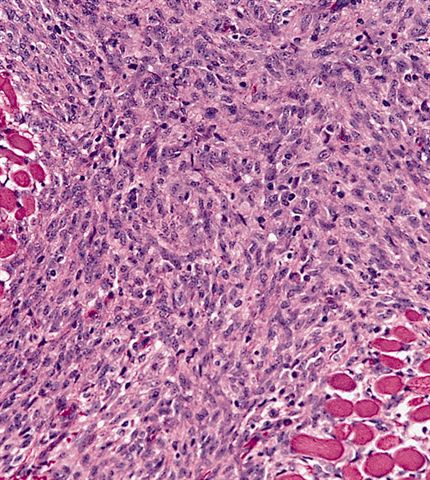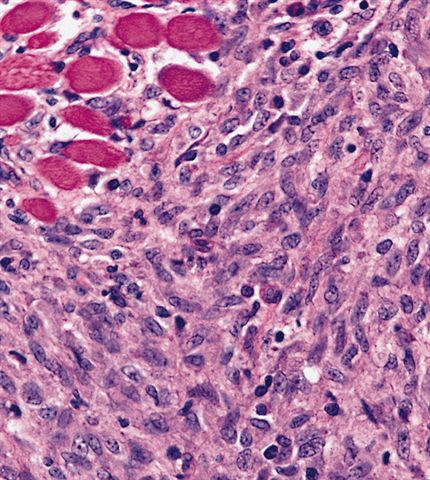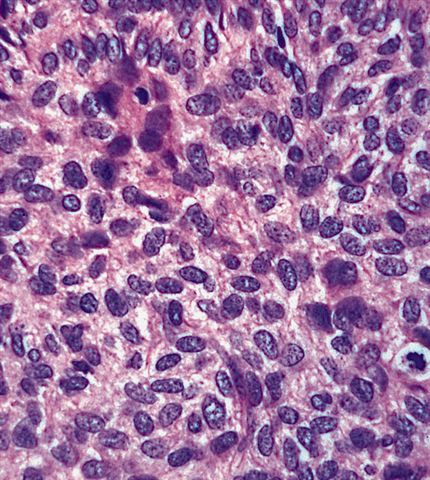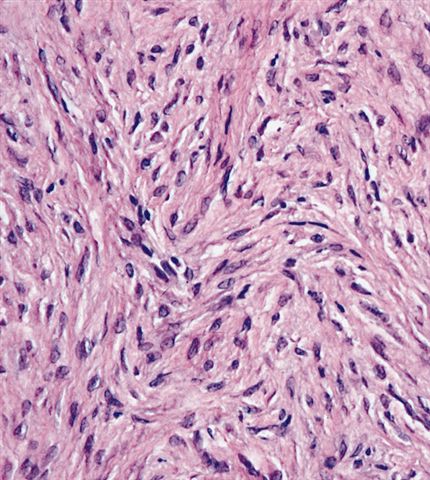Table of Contents
Definition / general | Essential features | Terminology | ICD coding | Epidemiology | Sites | Pathophysiology | Etiology | Clinical features | Diagnosis | Radiology description | Radiology images | Prognostic factors | Case reports | Treatment | Gross description | Gross images | Microscopic (histologic) description | Microscopic (histologic) images | Virtual slides | Positive stains | Negative stains | Electron microscopy description | Molecular / cytogenetics description | Videos | Sample pathology report | Differential diagnosis | Additional references | Board review style question #1 | Board review style answer #1 | Board review style question #2 | Board review style answer #2Cite this page: Azar P, Warmke L. Infantile fibrosarcoma. PathologyOutlines.com website. https://www.pathologyoutlines.com/topic/softtissuefibrosarcomainfantile.html. Accessed March 30th, 2025.
Definition / general
- Fibroblastic tumor, most commonly occurring in infancy
- Locally aggressive but infrequently metastasizes
- Characterized by ETV6::NTRK3 fusion or other fusions leading to oncogenic activation of tyrosine kinase signaling
Essential features
- Occurs in infants and young children
- Primitive ovoid / round cell or spindle cell tumor arranged in sheets or fascicles with hemangiopericytoma (HPC)-like vessels
- ETV6::NTRK3 fusion or other fusions / activating alterations of receptor tyrosine kinase pathway genes (e.g., NTRK1, NTRK2, NTRK3, RET, MET, BRAF)
Terminology
- Congenital fibrosarcoma
- Cellular congenital mesoblastic nephroma (analogous tumor in kidney)
ICD coding
- ICD-O: 8814/3 - infantile fibrosarcoma
- ICD-11: 2B5F.2 & XH7BC6 - sarcoma, not elsewhere classified of other specified sites & infantile fibrosarcoma
Epidemiology
- Congenital or tends to arise in the first 2 years of life
- Median age is 3 - 4 months (Cancer 1976;38:729)
- Majority (75%) occur during the first year of life
- < 10% occur in older children and adults (Am J Surg Pathol 2018;42:28)
- Slight male predominance
Sites
- Most commonly involves the superficial and deep soft tissues of the extremities
- Less commonly occurs on trunk and in head and neck region
- Intra-abdominal, retroperitoneal and visceral sites have been reported (Cancer 1976;38:729, Fetal Pediatr Pathol 2011;30:329)
- Analogous tumors in the kidney are designated as cellular congenital mesoblastic nephroma (Cancer Res 1998;58:5046, Nat Commun 2018;9:2378)
Pathophysiology
- Oncogenesis is through the activation of kinase signaling, most commonly from in frame gene fusions or less frequently, through activating mutations (Nat Commun 2018;9:2378)
- Most frequent genetic alteration is the ETV6::NTRK3 gene fusion resulting from the t(12;15)(p13;q25) chromosomal translocation
- Other NTRK3 fusion partners have been reported, including EML4::NTRK3 fusions (Mod Pathol 2018;31:463)
- Alternative fusions have been described involving other tyrosine kinase genes, including NTRK1, NTRK2, RET, MET and RAF1 (Am J Surg Pathol 2019;43:374, Am J Surg Pathol 2018;42:28)
- BRAF fusions, complex deletions and point mutations have been described (Am J Surg Pathol 2018;42:28, Nat Commun 2018;9:2378)
Etiology
- Unknown
Clinical features
- Large solitary neoplasm
- Typically presents as a painless mass or exophytic nodule
- Rapid growth may occur (Cancer 1976;38:729)
- Overlying skin may be ulcerated
- Dilated vessels and hemorrhage may be present, resembling a vascular tumor (Pediatr Dermatol 2006;23:330, Pediatr Radiol 2014;44:1124)
Diagnosis
- Biopsy and histological examination are necessary for definitive diagnosis
Radiology description
- Variable findings on multiple imaging modalities
- Large soft tissue mass
- May show osseous erosion
- Ultrasound
- Often the first imaging method used for palpable soft tissue masses
- Solid to complex with solid and cystic components
- Variable echogenicity
- Hypervascularity is seen in the majority of cases, which can lead to being misdiagnosed as vascular malformation (Clin Radiol 2022;77:e532)
- Magnetic resonance imaging (MRI)
- Solid and cystic with heterogeneous intensity and enhancement
- Highly cellular component makes it hyperintense on T2 weighted scans
- Isointense on T1 weighted imaging relative to skeletal muscle
- Heterogeneous enhancement with well defined margins
- Hemorrhagic components and necrosis are more common in larger masses (Radiographics 2016;36:1195)
- Calcifications and osseous involvement are rare
Radiology images
Prognostic factors
- Overall favorable prognosis with treatment
- Locally aggressive, infrequently metastatic tumor
- With surgery or cytotoxic chemotherapy, the 10 year overall survival rate is ~90% (Cancer 1976;38:729)
- Spontaneous regression is rare but has been reported
- Local recurrence rates range from 20 to 40%
- Subset of patients (8 - 15%) develop metastasis (Am J Surg Pathol 2019;43:435)
- Mortality ranges from 5 to 25%
Case reports
- Newborn girl presented with a rapidly enlarging perineal mass discovered on prenatal ultrasonography (BMC Pediatr 2023;23:327)
- 25 day old boy presented with a large, hypervascular abdominal wall mass (Radiol Case Rep 2024;19:3176)
- 6 month old boy presented with an enlarging tongue mass (Cureus 2023;15:e49586)
- 2 year old boy presented with a mass in the distal radius (J Orthop Case Rep 2023;13:58)
Treatment
- Complete excision with tumor free margins may be difficult
- Combined chemotherapy and surgery
- Targeted tyrosine kinase inhibitor therapies may be used
- Larotrectinib has been shown to help successfully treat tumors with NTRK fusions (Pediatr Blood Cancer 2020;67:e28330, Cancer Discov 2015;5:1049)
Gross description
- Size of the tumor varies, ranging from 10 to > 150 mm
- Poorly circumscribed tumor, infiltrating into the surrounding soft tissue
- Subset have a thin, fibrous pseudocapsule (Cancer 1977;40:1711, Am J Surg Pathol 2019;43:435)
- Firm, gray-white cut surface
- Hemorrhagic and necrotic foci are often present
Gross images
Microscopic (histologic) description
- Cellular neoplasm composed of primitive, immature tumor cells
- Plump, spindled, immature appearing fibroblastic tumor cells arranged in short fascicles
- Usually very little cellular pleomorphism
- Scattered chronic inflammatory cells, especially lymphocytes, interspersed between tumor cells
- Prominent chronic inflammation may be present (Cancer 1976;38:729)
- Often has prominent ectatic or hemangiopericytoma-like vasculature
- Background stroma may be myxoid or collagenous
- Subset of cases may have decreased cellularity mimicking a benign lesion (Pediatr Dev Pathol 2012;15:127)
- Mitotic counts range widely with no atypical mitotic forms (Cancer 1976;38:729)
- Areas of tumor necrosis or hemorrhage are frequent
Microscopic (histologic) images
Contributed by Jessica L. Davis, M.D. and AFIP
Positive stains
- Pan-TRK in tumors harboring NTRK gene rearrangements, nuclear staining in lesions with NTRK3 fusions and cytoplasmic staining in lesions with NTRK1 and NTRK2 fusions (Histopathology 2018;73:634)
- SMA (variable)
- S100 protein (variable)
- CD34 (variable)
Negative stains
- Desmin (rarely positive)
- MyoD1
- Myogenin
- CK cocktail
Electron microscopy description
- Features of fibroblasts and myofibroblasts (Adv Anat Pathol 2004;11:190)
- Large tumor cell nuclei
- Dilated rough endoplasmic reticulum
- Abundant lysosomes
Molecular / cytogenetics description
- Gene fusions or activating alterations involving receptor tyrosine kinase or downstream effector molecules (Am J Surg Pathol 2000;24:937)
- Most cases contain chromosomal translocation t(12;15)(p13;q26), corresponding to an NTRK3::ETV6 gene fusion
- Other NTRK3 fusion partners have been reported (e.g., EML4::NTRK3)
- Alternate fusions involving other tyrosine kinase genes have been reported with a variety of fusion partners (e.g., NTRK1, NTRK2, MET, RET, BRAF)
Videos
Fibrosarcoma and herringbone pattern
Sample pathology report
- Soft tissue, right arm, mass, excision:
- Infantile fibrosarcoma (see comment)
- Comment: Sections show a highly cellular neoplasm composed of monotonous, primitive spindle cells with a fascicular growth pattern and scattered hemangiopericytoma-like vessels. Numerous mitotic figures and focal areas of necrosis are present. Immunohistochemical stains show that the tumor cells are positive for vimentin and pan-TRK, while they are negative for CK cocktail, S100 protein and desmin. Additional molecular testing revealed a NTRK3::ETV6 fusion, supporting the above diagnosis.
Differential diagnosis
- Desmoid fibromatosis:
- Bland spindle cell proliferation
- Low proliferative activity
- Nuclear expression of beta catenin
- May be associated with familial adenomatosis polyposis (Gardner syndrome)
- Infantile myofibroma / myofibromatosis:
- Biphasic growth
- Mature spindled myogenic tumor cells
- Immature ovoid tumor cells with numerous vessels
- Immunohistochemical expression of actins
- Recurrent PDGFRB alterations
- Do not metastasize to distant sites
- May occur as solitary tumors or multiple tumors with or without visceral involvement
- Congenital / infantile spindle cell rhabdomyosarcoma:
- Scattered rhabdomyoblasts
- Focal expression of desmin and myogenin
- Gene fusions involving VGLL2, SRF, TEAD1, NCOA2 and CITED2 (Genes Chromosomes Cancer 2013;52:538, Am J Surg Pathol 2016;40:224)
- In older children, spindle cell rhabdomyosarcoma may have a MYOD1 p.L122R point mutation
- Inflammatory myofibroblastic tumor:
- Occurs most often in viscera and deep soft tissue
- Myxoid stromal changes are usually present
- Prominent inflammatory infiltrate with lymphocytes and plasma cells
- Immunohistochemical expression of ALK in 40 - 60% of cases
- Some patients develop a constitutional inflammatory syndrome including fever, malaise, weight loss and anemia
- Low grade myofibroblastic sarcoma:
- Usually occurs in adults
- Diffuse infiltration of preexisting structures
- Tumor necrosis is usually absent
- Predilection for head and neck sites
Additional references
Board review style question #1
Board review style answer #1
C. NTRK3::ETV6. NTRK3::ETV6 gene fusions are most commonly seen in infantile fibrosarcoma and correspond to the t(12;15)(p13;q26) chromosomal translocation. Answer A is incorrect because COL1A1::PDGFB fusions are associated with dermatofibrosarcoma protuberans (DFSP). Answer D is incorrect because SS18::SSX fusions are seen in synovial sarcoma. Answer B is incorrect because EWSR1::ATF1 fusions may be seen in clear cell sarcoma of soft tissue.
Comment Here
Reference: Fibrosarcoma-infantile
Comment Here
Reference: Fibrosarcoma-infantile
Board review style question #2
Board review style answer #2
A. Cellular congenital mesoblastic nephroma. Cellular congenital mesoblastic nephroma is analogous to infantile fibrosarcoma, occurs in the kidney and has the identical gene fusion. Answers B, C and D are incorrect because infantile myofibroma, cellular infantile fibromatosis and spindle cell rhabdomyosarcoma are all not analogous to infantile fibrosarcoma and do not carry the same fusion.
Comment Here
Reference: Fibrosarcoma-infantile
Comment Here
Reference: Fibrosarcoma-infantile












